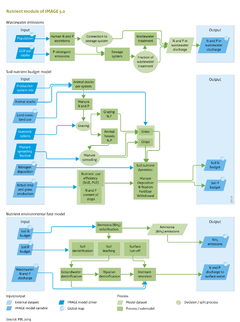Nutrients/Description: Difference between revisions
Jump to navigation
Jump to search
No edit summary |
No edit summary |
||
| Line 30: | Line 30: | ||
====Biological N2 fixation==== | ====Biological N2 fixation==== | ||
Data on biological N2 fixation by leguminous crops (pulses and soybeans) are obtained from the N in the harvested product (see nutrient withdrawal) following the approach of ([[Salvagiotti et al., 2008]]). Thus any change in the rate of biological N2 fixation by legumes is the result of yield changes for pulses and soybeans. In addition to leguminous crops, IMAGE uses an annual rate of biological N2 fixation of 5 kg N per ha for non-leguminous crops and grass, and 25 kg N per ha for wetland rice. N fixation rates in natural ecosystems were based on the low estimates for areal coverage by legumes ([[Cleveland et al., 1999]]) as described by Bouwman et al. ([[Bouwman et al., 2013a|2013a). | Data on biological N2 fixation by leguminous crops (pulses and soybeans) are obtained from the N in the harvested product (see nutrient withdrawal) following the approach of ([[Salvagiotti et al., 2008]]). Thus any change in the rate of biological N2 fixation by legumes is the result of yield changes for pulses and soybeans. In addition to leguminous crops, IMAGE uses an annual rate of biological N2 fixation of 5 kg N per ha for non-leguminous crops and grass, and 25 kg N per ha for wetland rice. N fixation rates in natural ecosystems were based on the low estimates for areal coverage by legumes ([[Cleveland et al., 1999]]) as described by Bouwman et al. ([[Bouwman et al., 2013a|2013a]]). | ||
====Atmospheric deposition==== | ====Atmospheric deposition==== | ||
Revision as of 16:33, 20 May 2014
Parts of Nutrients/Description
| Component is implemented in: |
| Components: |
| Related IMAGE components |
| Projects/Applications |
| Key publications |
| References |
